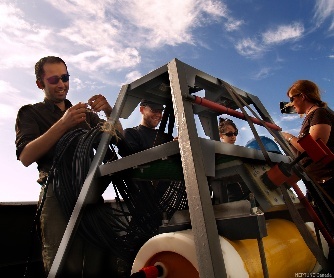Controlled-Source Electromagnetic System (CSEM)
The CSEM Project
At ODP 889, gas hydrates increase the resistivity and stiffness of marine sediment. The CSEM is a stationary imaging experiment that generates data sensitive to changes in these sediment properties. Using the NEPTUNE Regional Network, the CSEM provides continuous, real-time monitoring of the “Bullseye” cold vent offshore Vancouver Island.
The CSEM sends a precise electromagnetic signal from a transmitter (TX) dipole which is recorded at several seafloor receiver (RX) dipoles located at a range of distances from the transmitter. The subtle changes in resistivity of the sediment between the TX and RXs is due to the displacement of conductive pore water by electrically-insulating gas hydrate. Throught repeated soundings, the CSEM will track changes in resistivity and reveal the evolution of the gas hydrate deposit. The CSEM method used is described theoretically by Edwards (1997) and experimentally by Schwalenberg et al (2005).
CSEM Deployment
The CSEM equipment consists of a transmitter, affixed to a small instrument platform, and a string of 5 receivers, spaced 200m apart along a 1km cable. During installation, the cable and receivers were spooled onto a drum, which was connected to ROCLS. Both of these payloads were lowered by winch from the deck of the R/V Thompson to the seafloor.
The CSEM deployment involved two ROPOS dives and two equipment drops using the ship's winch. The man of the hour during all of this was University of Toronto doctoral candidate Reza Mir, who joined the installation cruise to help coordinate and oversee installation.
Once the ROCLS spool and the transmitter platform were placed on the seafloor, ROPOS flew down, attached to ROCLS, laid the 1km reciever string and recovered ROCLS to the ship. In the following dive, ROPOS again located the transmitter platform, arranged two heavy dipoles on the seafloor nearby, connected it to the receiver string and connected the ODP 889 instrument platform to the CSEM platform.
CSEM on deck. Click to enlarge photo.

3 Comments
Unknown User (dwowens)
Discuss NEPTUNE Canada's CSEM Experiment (click Add Comment below.)
Eleanor Willoughby
All of us in the U of T team (Nigel, Reza, Andrei and I) who are currently in New Zealand, are very happy to say that our communication test last night was a great success. Thanks to Martin, we were able to communicate with the Transmitter (TX), the Receiver Controller (RC) and all 5 Receivers (RX). This is the first time this sort of experiment has ever been done and we are very pleased it is alive and well!
Thanks to all who helped make this a reality: Peter Hurley (PERC, U of T), Shuqing Li (PERC, U of T) and the NEPTUNE staff, especially Reece Hasanen, Martin Hoffmann, Benoît Pirenne, Mairi Best, and Peter Phibbs.
Dwight Owens
Fantastic great news! I'd like to offer a hearty congrats to you all, especially Reza, who was sweating bullets to get the CSEM deployed last fall, and has likely endured many a sleepless night ever since, wondering when and if this day would come!
I think we must be living in the 21st century when researchers from Toronto, who happen to find themselves in New Zealand, can work remotely with collaborators in Vancouver, Victoria, Port Alberni, and on a ship plying the high seas, to remotely test a cutting-edge device that's sitting on the seafloor, 1258m below the surface and connected via subsea cables to the world wide web!
PS to Reza: You the Sheriff, man!